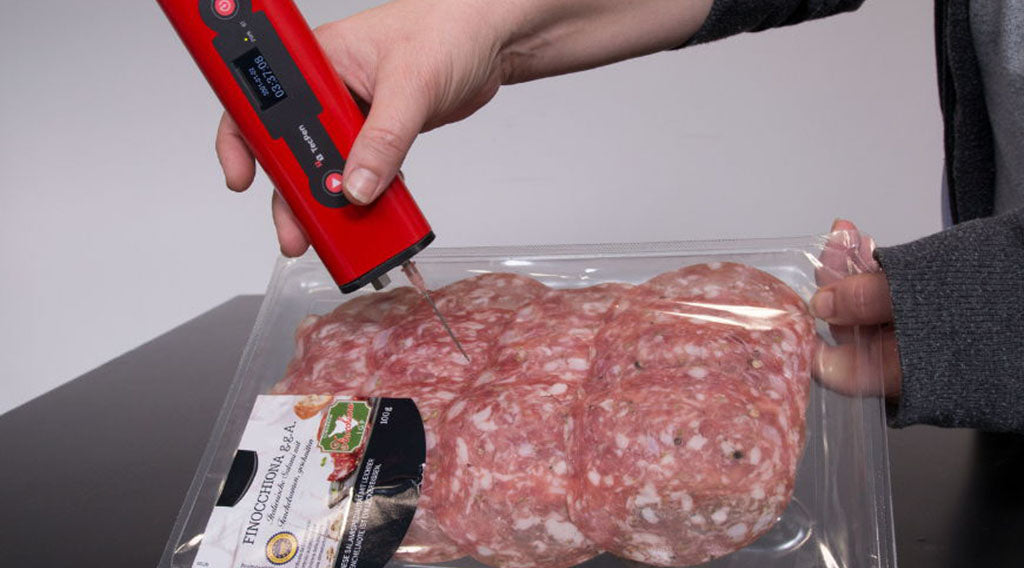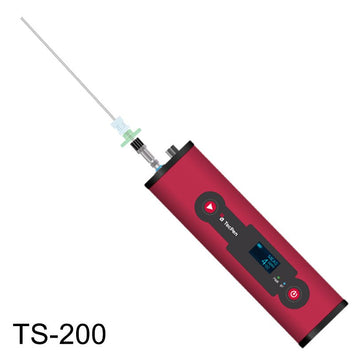
Modified atmosphere packaging testing is required to validate the mixture of gases inside a sealed container of meat, fruit, vegetables, drinks, pharmaceuticals or any consumable products.
Even small variations of oxygen, nitrogen, carbon dioxide or water vapor inside a sealed package can have a large impact on product spoilage as well as product attractiveness to the end consumer. Given the importance of providing safe consumables to customers, it isn’t enough to maximize product safety – packagers need to test and verify the safety too.
- What is Modified Atmosphere Packaging?
- How Does a MAP Handheld Oxygen Sensor Work?
- Beyond MAP - Controlled Atmosphere Testing
- MAP During Packaging
- Is Modified Atmospheric Packaging Safe?
What is Modified Atmosphere Packaging?
Food does not stay fresh forever: lettuce wilts, milk spoils, and meat develops a strange smell. Several circumstances cause food to spoil. One of the major factors behind how quickly vacuum packed or other packaged foods become perishable is the level of oxygen inside the package. Oxygen in the packaged space can cause decay, both by oxidation and by the growth of aerobic microorganisms like molds and yeasts. One way to slow down this process is the use of modified atmosphere packaging.
Modified atmosphere packaging, known in the food industry as MAP, is used to flush air from food storage containers or vacuum-sealed wraps and replace it with a known-gas mixture, typically nitrogen and/or carbon dioxide. Removing the oxygen allows fresh fruits, dairy products and packaged foods to maintain its nutritional appeal and provides extended shelf-life without the need for chemicals. In addition, a MAP system can meet the brand standards for high-quality and consistency required by food manufacturers bottlers (packaging headspace) and pharmaceutical companies.
While modified atmosphere packaging is not new, the technology has become more sophisticated over time.
The MAP environment is created from a carefully balanced mix of inert gas. The package is flushed with a mixture of known gases and sealed. In the case of vacuum packaging, all the gases in the package are removed.
Nitrogen (N2) used to displace oxygen in a sealed package has the side-effect of eliminate moisture from the product. Since all gaseous environments seek equilibrium, the moisture in the product will mix with the nitrogen gas. For this reason, nitrogen is often used during MAP for products like chips, pharmaceuticals or packaging of electronics where additional moisture is not desirable.
To stop the reduction in moisture content in fresh produce, a mixture of nitrogen and carbon dioxide (CO2) are used. CO2 also supports moisture while lowering pH, making the residual moisture more acidic and reducing the environment for bacterial growth and eliminating potential food borne illness. The optimal result slows down product expiration, reduces color loss, and overall preserves the food in its freshest state. In the US, carbon monoxide may be used to improve the color of red meats.
Common to all these details is the measurement of the remaining oxygen in the modified atmosphere inside the package. To test the remaining gas, a random sample of packaged products are tested. If the sample shows no presence of oxygen, the packager can be confident the MAP system on the production line is working properly.
How Does a MAP Handheld Oxygen Sensor Work?
Handheld oxygen sensors are used to test oxygen levels in food or pharmaceutical packaging facilities. Samples of the final packaged product are randomly pulled from the production line for testing. The gases inside the package are "sucked" via vacuum through a hollow needle called a cannula into a tube and finally across an oxygen sensor. This allows for testing of the modified atmosphere inside the package. If the oxygen level is not low enough to meet the required standards for the package, it can be concluded that there is a problem with the modified atmosphere packaging machinery. The packaging line is stopped, the machinery is tested, and a sample is taken again.
One example of an oxygen sensor used for testing sealed packages is the TecPen Handheld Oxygen Sensor. It is designed to verify trace oxygen levels in closed food packaging. Inspectors use the TecPen by piercing the sealed packaging material and reading the oxygen level inside.
Because the measurement needs to be taken quickly with a small sample, the TecPen measures trace concentrations of oxygen by a technique known as fluorescent quenching by oxygen. A dye is briefly illuminated by a specific wavelength of light which causes the dye to fluoresce. If oxygen molecules touch the molecules of dye, the fluorescence is reduced, or “quenched.” If the amplitude of the emission and the decay time is known, the concentration of oxygen in the sample can be computed.
The process of excitation and measurement of emission happens at the kilohertz range, or thousands of times per second. This allows the TecPen to accurately measure oxygen levels from very small samples of gas. In addition, the TecPen can measure changes in oxygen levels as low as one part-per-million, or 1ppm.
What are the examples of Modified Atmosphere Packaged foods?
Beyond MAP - Controlled Atmosphere Testing
There are several steps in moving food from farms to grocery stores. During transportation, a variation of modified atmosphere packaging called controlled atmosphere (CA) storage is used. By combining low temperatures and a modified Atmosphere, CA maximizes storage life and minimizes spoilage. There are two places where CA is used before final packaging:
Controlled Atmosphere Testing After Harvesting
After harvesting fruit continues to live and respire until all of its internal stores of glucose have been depleted. The longer respiration continues, the longer the fruit will stay fresh.
For example, after apples are picked, they are moved into cold storage rooms to slow the respiration rate. The colder the environment, the slower the respiration and the longer the apples will keep until they are sold at market. Once the apples are chilled, nitrogen is pumped into the storage room. It is essential to test the oxygen levels during this phase, as it needs to be lowered from 21% to 1.2% to put the apples to “sleep.”
After the oxygen is removed, the CA storage room must be tested for both oxygen and carbon dioxide levels. While CO2 gas slows the ripening of apples, too much CO2 can ruin their taste and appearance. Therefore both oxygen and CO2 levels must be tested during storage.
Many types of apples can be preserved for 9–12 months in CA storage, as opposed to 2–3 months if using refrigerated storage alone.
Controlled Atmosphere Testing During Transportation
It is not uncommon for fresh produce to travel long distances from its point of harvest to its purchasing destination. During this time, it can be sealed in containers where the temperature and oxygen levels are kept low.
For example, CA storage now allows perishable foods to be inexpensively transported across the country by train car or around the world by ships. In both cases, CA storage packaging testing is required to insure there are no leaks in the storage containers.
MAP During Packaging
During the fresh food packaging process, the packages are sealed immediately after the oxygenated air is removed.
Different foods require different levels of gases in the packaging to stay fresh. For example, fruits and vegetables should ideally be packaged in 1-5% Oxygen, 2-15% CO2, and 80-95% nitrogen. Red meat is typically packaged in 30% CO2 and 70% nitrogen. Dried food such as potato chips are often packaged in 100% nitrogen.
Modified atmospheric packaging testing equipment like the TecPen are a reliable way to test oxygen levels during the packaging process to meet industry standards and protect overall consumer safety.
Is Modified Atmospheric Packaging Safe?
The answer to the question “Is MAP packaging safe?” is an unqualified "yes.” Artificially managing the air in and around stored foods has been a well-known technique since the time of the ancient Egyptians. The beneficial effects of MAP are that it improves food quality, enables a longer product shelf life and makes the storage and transportation of fresh foods possible without the need for chemicals. Every food production industry in the world relies on MAP. However, to be 100% efficient, testing is required. This is why modified atmospheric packaging testing is so important.
Sources:
https://foodcrumbles.com/respiration-fruits-vegetables/
https://www.co2meter.com/blogs/news/7425044-what-is-modified-atmosphere-processing








